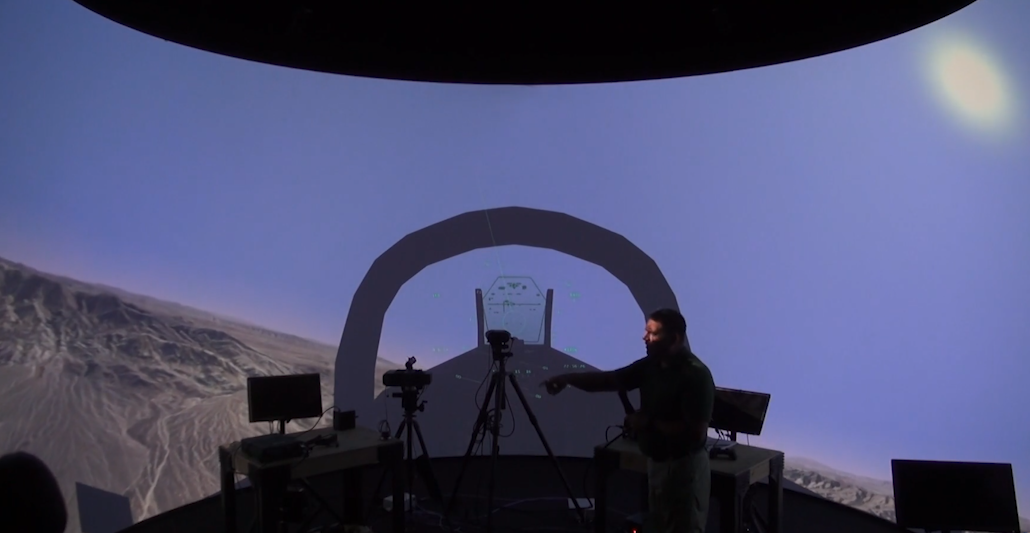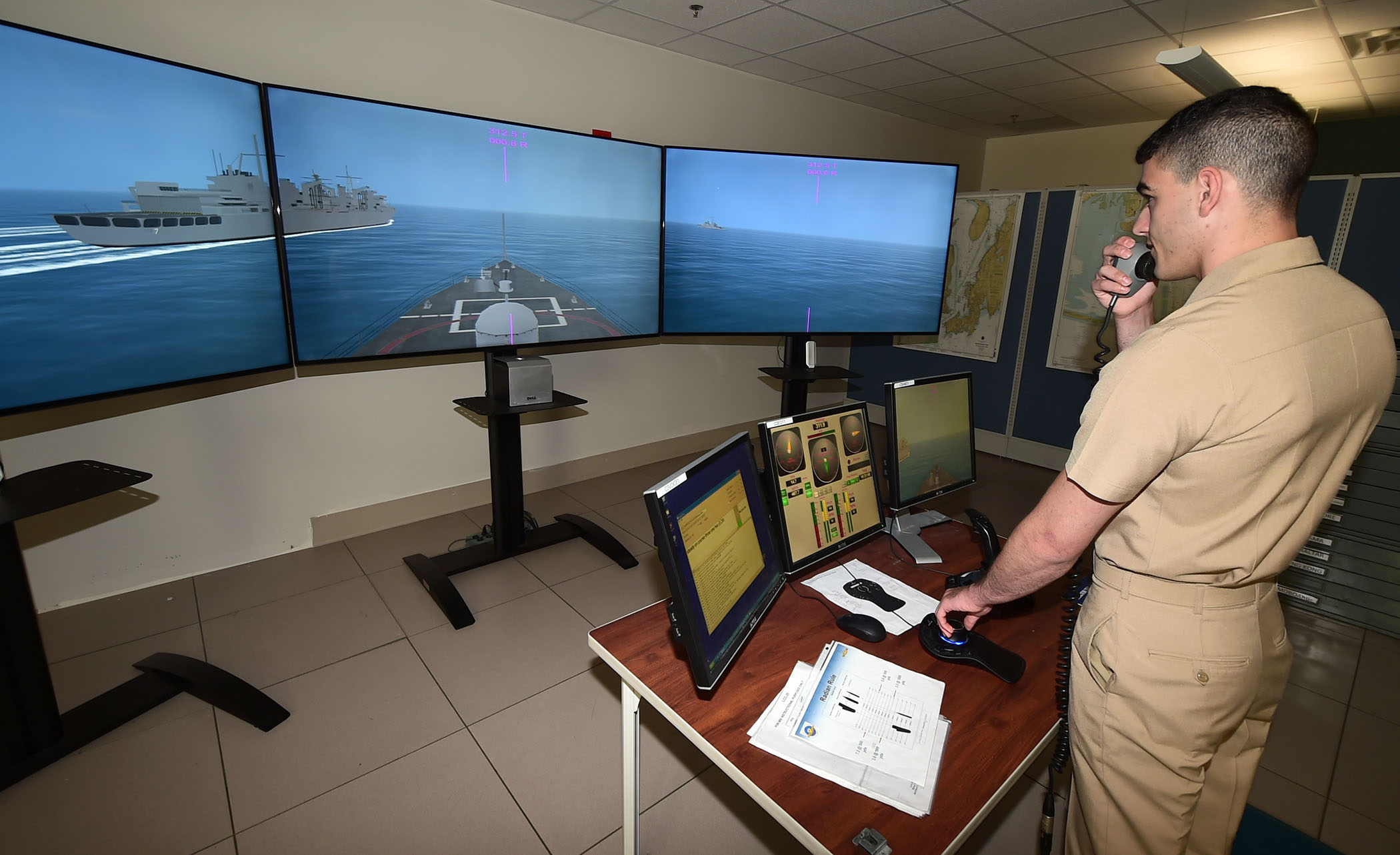
Aircraft from Carrier Air Wing (CVW) 11 fly in close formation during a flight demonstration as part of Tiger Cruise 2017 aboard the aircraft carrier USS Nimitz (CVN 68) in November 2017. US Navy photo.
NAVAL AIR STATION FALLON, Nev. — The future of naval aviation is complex: aircraft are growing more technologically advanced, pilots face a proliferation of high-end and low-end threats, military budgets are squeezed and demand for U.S. Navy forces around the globe is growing.
So how will naval aviation training keep up? In part, with increasingly sophisticated simulators.
The Naval Aviation Warfighting Development Center at NAS Fallon is undergoing a massive modernization effort to improve air warfare training, and much of the modernization revolves around the use of Live, Virtual and Constructive (LVC) training opportunities.
Naval aviation and NAWDC leadership invited USNI News to tour the facilities for a day to see how technology is allowing the Navy to make its training more cost-efficient, more networked, more high-end and more beneficial to the students.
The CAVE

NAS Fallon CAVE simulator. US Navy Photo
One of the biggest leaps in capability at NAS Fallon was demonstrated last summer at the CAVE – a dome-shaped Combined Arms Virtual Environment simulator primarily used for training Joint Terminal Attack Controllers who, from the ground, coordinate with pilots in the air to identify and mark targets for air strikes.
The five-week JTAC course at Fallon now includes two weeks in a classroom and then one week in the CAVE before students head to the training range for live practice.
In a feat that combined live training and simulator training, “In August of this past year we had essentially a live, virtual and constructive demo. … We took equipment that’s already on the aircraft that broadcasts the aircraft’s altitude, airspeed, position in real time, and we put a transmitter or receiver unit on the top of the building here. We were able to tap into that feed, and what that did was it took the aircraft’s, that feed of an actual aircraft on the range, and we piped it into the sim (simulator), and it was accurately recreated in the virtual environment,” Maj. Jonathan Reed, Joint Close-Air Support (JCAS) branch head within NAWDC’s strike department, told USNI News during the Feb. 21 tour.
“The no-kidding aircraft is actually flying on the range and is properly displayed in the sim with very low to minimal latency in a real-time altitude, airspeed, attitude in the sim. So what that provided for is a real-time control of that aircraft – which was a Type 1 control in close-air support realm, means that you have the ability to see the aircraft as well as have the ability to see the target – so in the sim the JTAC can see the aircraft that’s actually on the range. … The JTAC is able to look up and actually assess the attitude and profile of that aircraft … and then provide the clearance to essentially employ munitions on the desired intended target.”
Reed said 90 percent of the students that come through the facility are Navy Special Warfare personnel, either SEALs or Special Warfare Combatant-Craft Crewmen, with the remaining 10 percent coming from naval aviation or from Navy Expeditionary Combat Command riverine squadrons. Students could find themselves in combat within a week of completing the JTAC course, he said, so the training must be excellent.
T.J. Gusewelle, the JCAS program manager, said the simulator has done a lot to increase the quality of the JTACs graduating from the course.
“Before we had the simulator, the guys were really slow in the first few days on the range because that’s the first time that they did it. But now getting a week of practice in here … you get better control and better performance on the range with the live assets, so it makes it more efficient. So the simulator is awesome, it’s invaluable as far as getting the guys ready to go,” he said.
Cmdr. Corey Pritchard, the NAWDC strike department head, said it has been harder and harder to get fleet aircraft that can support JTAC training at NAS Fallon, both due to a high operational tempo and due to challenges in keeping the aircraft ready to fly.
“So the more training we can get them here, the better they are when they actually get to an actual aircraft,” Pritchard said.
“So they’re not stumbling on Day 1, they’re already semi-proficient or trying to get there, whereas in the past before they had this (CAVE simulator) – I know when I went through the JTAC course, you’re a mess your first several times, so it’s good training for you, but for the guys airborne, they’re holding for a half hour just to get a bomb off because the guy (on the ground) is learning what to do.”
Rear Adm. Dan Cheever, the commander of NAWDC, told USNI News that the CAVE has created “a dramatic improvement in the first pass drop and the communications on the radio and everything. They really do wring everything out here, so by the time that they’re on the range it’s just the real-life stuff that hits you. … A lot more first-pass drops, which is the whole goal of close-air support.”
Reed, the JCAS branch head, said NAWDC is still trying to get the authority to connect CAVE to the Navy’s continuous training environment (NCTE), and that while that decision has been delayed, he hoped to have it within the next 12 to 16 months. A decision to link CAVE to the rest of the trainers would help create NAWDC’s ultimate vision for this JTAC trainer: “what we will eventually be able to do is put this into a guy in a F-18 simulator or an F-35 simulator at (NAS) Oceana or Lemoore, and they’ll be running this simulator, talking to the guys in this simulator, and doing all their controls to get their currency requirements to satisfy their training” while taking their targeting cues from JTAC students in their own simulator in Fallon, Gusewelle said.
Integrated Simulator Training

Navy ROTC Midshipman 2nd Class Ghazi Mazzal, an incoming junior at the University of Maryland Baltimore County, virtually cons a ship at sea during the 2017 Navy ROTC National Shiphandler of the Year competition at the Surface Warfare Officers School (SWOS) in August 2017. US Navy photo.
A next step towards achieving that vision of connecting multiple simulators spread across the country is the Integrated Training Facility being constructed at NAS Fallon. This will house, all under one roof, simulators for “pretty much anything in the carrier strike group,” Capt. Leif Steinbaugh, director of training systems at NAWDC, told USNI News.
“We’ll be able to integrate them all together. Eventually we will be able to pipe in feeds from live aircraft out on our range – that’s the live part, the L in LVC – and then vice versa hopefully we can pipe what’s being seen in the simulators, or what’s being constructed in the simulators, out to the live aircraft as well. And then hopefully sometime in the future we’ll get that building connected to other LVC facilities, not only in the Navy, in naval aviation, but also with our joint partners,” he continued, noting that Nellis Air Force Base, about a six-hour drive to the south, would be the first targeted facility for cross-location LVC training.
In addition to the Integrated Training Facility, set to wrap up construction by the end of 2019 and open for operations within three to four years, NAWDC is also building an Air Wing Training Facility, set to finish construction in May. This building will allow the same air wing training that takes now, but at a more appropriate security level and in a way that allows for much more data collection.
Today, NAWDC staff manually log information on the air wings, squadrons and individual pilots that cycle through for pre-deployment training.
“What we want to be able to do in the future, and this facility is the first step, is machine-to-machine data gathering. And that will allow us to gather large amounts of data – so not just necessarily how they did on that event, in the actual actions they took on that event, but we can also gather historical data on the aircraft, its system, how well the systems have held up. We can look at, automatically, machine-to-machine, look at the pilot and how proficient he is, how much flight time he or she received recently, and that will all help us build that bigger picture so we can inform leadership with the best information we can give them,” he said.
Though all air wings are given the same syllabus for training at Fallon, Steinbaugh said they have “different paths” that get them to Fallon – some air wings were better funded than others, some saw more extreme readiness issues with non-mission-capable aircraft, some are heading out for the first deployment in a while and some are heading out for a surge deployment within the Optimized Fleet Response Plan setup, and so on. So tracking not only the pilots’ performance and the performance of the unit as a whole, but also comparing that performance data with other relevant data, “will allow us to build that bigger picture” that can help Navy leadership make informed decisions on funding, training and readiness issues.
NAWDC also runs an Air Defense Strike Group Facility, which was put together as a rapid prototype capability until the larger Integrated Training Facility could be built.
Lower-end Threats

Commander of Naval Air Forces Vice Adm. DeWolfe Miller uses a surface-to-air missile launcher simulator at Naval Air Station Fallon, Nev., on Feb. 21, 2018.
Despite the focus on high-end warfare and sophisticated enemy technologies U.S. Navy aviators could face, equally dangerous are less expensive threats like shoulder-launched anti-air missiles. To that end, NAWDC has also invested in a slew of Surface-to-Air Missile simulators to help ensure that pilots cycling through NAWDC training events are aware of the threats they face on the ground and are flying with tactics that would keep them safe.
Justin Clark, an electronics technician at NAWDC who works with the SAM simulators, showed the ease with which a man on the ground could target a fighter jet in the air – he pointed his SA-16 simulator up in the air, it locked on to the jet’s heat signature, and “fired” a simulated shot.
Though the SAM simulators aren’t connected to the planes in the air – so the pilot didn’t know in real-time he had been “shot” at with the simulator – the simulator logs video of the encounter. That video is incorporated into the pilot’s debrief after a training event, with the teachers explaining to the pilot whether his flight profile would have kept him safe or put him at risk to ground threats, Clark explained.
NAWDC has SA-16, SA-18 and other missile launcher simulators, as well as an ultraviolet stimulator meant to set off an aircraft’s countermeasures system.
“This is how they prove to our guys, you’re reachable, you need to be careful and you need to know what you’re doing, get your tactics right,” Cheever said.
“Everything that’s out there is beatable, you’ve just got to know what you’re doing, but you’ve got to get your tactics right.”
